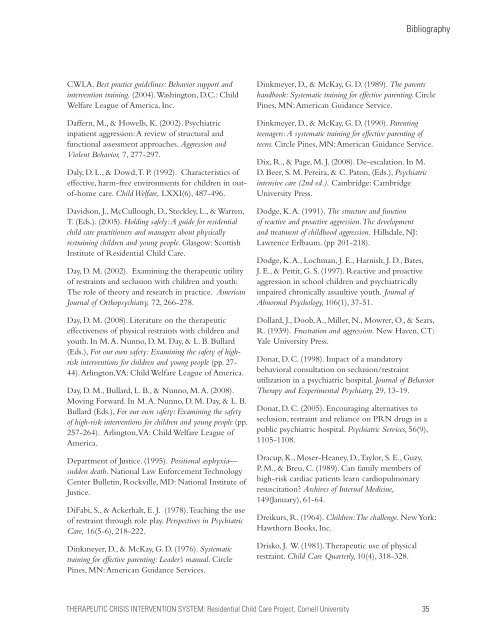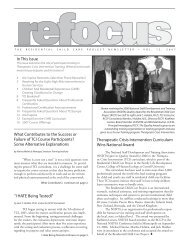The Therapeutic Crisis Intervention System - Residential Child Care ...
The Therapeutic Crisis Intervention System - Residential Child Care ...
The Therapeutic Crisis Intervention System - Residential Child Care ...
Create successful ePaper yourself
Turn your PDF publications into a flip-book with our unique Google optimized e-Paper software.
CWLA. Best practice guidelines: Behavior support and<br />
intervention training. (2004). Washington, D.C.: <strong>Child</strong><br />
Welfare League of America, Inc.<br />
Daffern, M., & Howells, K. (2002). Psychiatric<br />
inpatient aggression: A review of structural and<br />
functional assessment approaches. Aggression and<br />
Violent Behavior, 7, 277-297.<br />
Daly, D. L., & Dowd, T. P. (1992). Characteristics of<br />
effective, harm-free environments for children in outof-home<br />
care. <strong>Child</strong> Welfare, LXXI(6), 487-496.<br />
Davidson, J., McCullough, D., Steckley, L., & Warren,<br />
T. (Eds.). (2005). Holding safely: A guide for residential<br />
child care practitioners and managers about physically<br />
restraining children and young people. Glasgow: Scottish<br />
Institute of <strong>Residential</strong> <strong>Child</strong> <strong>Care</strong>.<br />
Day, D. M. (2002). Examining the therapeutic utility<br />
of restraints and seclusion with children and youth:<br />
<strong>The</strong> role of theory and research in practice. American<br />
Journal of Orthopsychiatry, 72, 266-278.<br />
Day, D. M. (2008). Literature on the therapeutic<br />
effectiveness of physical restraints with children and<br />
youth. In M. A. Nunno, D. M. Day, & L. B. Bullard<br />
(Eds.), For our own safety: Examining the safety of highrisk<br />
interventions for children and young people (pp. 27-<br />
44). Arlington, VA: <strong>Child</strong> Welfare League of America.<br />
Day, D. M., Bullard, L. B., & Nunno, M. A. (2008).<br />
Moving Forward. In M. A. Nunno, D. M. Day, & L. B.<br />
Bullard (Eds.), For our own safety: Examining the safety<br />
of high-risk interventions for children and young people (pp.<br />
257-264). Arlington, VA: <strong>Child</strong> Welfare League of<br />
America.<br />
Department of Justice. (1995). Positional asphyxia—<br />
sudden death. National Law Enforcement Technology<br />
Center Bulletin, Rockville, MD: National Institute of<br />
Justice.<br />
DiFabi, S., & Ackerhalt, E. J. (1978). Teaching the use<br />
of restraint through role play. Perspectives in Psychiatric<br />
<strong>Care</strong>, 16(5-6), 218-222.<br />
Dinkmeyer, D., & McKay, G. D. (1976). <strong>System</strong>atic<br />
training for effective parenting: Leader’s manual. Circle<br />
Pines, MN: American Guidance Services.<br />
Bibliography<br />
Dinkmeyer, D., & McKay, G. D. (1989). <strong>The</strong> parents<br />
handbook: <strong>System</strong>atic training for effective parenting. Circle<br />
Pines, MN: American Guidance Service.<br />
Dinkmeyer, D., & McKay, G. D. (1990). Parenting<br />
teenagers: A systematic training for effective parenting of<br />
teens. Circle Pines, MN: American Guidance Service.<br />
Dix, R., & Page, M. J. (2008). De-escalation. In M.<br />
D. Beer, S. M. Pereira, & C. Paton, (Eds.), Psychiatric<br />
intensive care (2nd ed.). Cambridge: Cambridge<br />
University Press.<br />
Dodge, K. A. (1991). <strong>The</strong> structure and function<br />
of reactive and proactive aggression. <strong>The</strong> development<br />
and treatment of childhood aggression. Hillsdale, NJ:<br />
Lawrence Erlbaum. (pp 201-218).<br />
Dodge, K. A., Lochman, J. E., Harnish, J. D., Bates,<br />
J. E., & Pettit, G. S. (1997). Reactive and proactive<br />
aggression in school children and psychiatrically<br />
impaired chronically assaultive youth. Journal of<br />
Abnormal Psychology, 106(1), 37-51.<br />
Dollard, J., Doob, A., Miller, N., Mowrer, O., & Sears,<br />
R. (1939). Frustration and aggression. New Haven, CT:<br />
Yale University Press.<br />
Donat, D. C. (1998). Impact of a mandatory<br />
behavioral consultation on seclusion/restraint<br />
utilization in a psychiatric hospital. Journal of Behavior<br />
<strong>The</strong>rapy and Experimental Psychiatry, 29, 13-19.<br />
Donat, D. C. (2005). Encouraging alternatives to<br />
seclusion, restraint and reliance on PRN drugs in a<br />
public psychiatric hospital. Psychiatric Services, 56(9),<br />
1105-1108.<br />
Dracup, K., Moser-Heaney, D., Taylor, S. E., Guzy,<br />
P. M., & Breu, C. (1989). Can family members of<br />
high-risk cardiac patients learn cardiopulmonary<br />
resuscitation? Archives of Internal Medicine,<br />
149(January), 61-64.<br />
Dreikurs, R. (1964). <strong>Child</strong>ren: <strong>The</strong> challenge. New York:<br />
Hawthorn Books, Inc.<br />
Drisko, J. W. (1981). <strong>The</strong>rapeutic use of physical<br />
restraint. <strong>Child</strong> <strong>Care</strong> Quarterly, 10(4), 318-328.<br />
THERAPEUTIC CRISIS INTERVENTION SYSTEM: <strong>Residential</strong> <strong>Child</strong> <strong>Care</strong> Project, Cornell University 35



